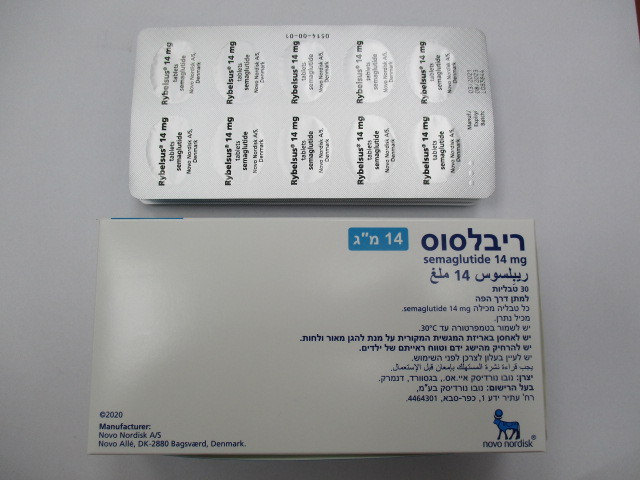Quest for the right Drug

ריבלסוס 14 מ"ג RYBELSUS 14 MG (SEMAGLUTIDE)
תרופה במרשם
תרופה בסל
נרקוטיקה
ציטוטוקסיקה
צורת מתן:
פומי : PER OS
צורת מינון:
טבליה : TABLETS
עלון לרופא
מינוניםPosology התוויות
Indications תופעות לוואי
Adverse reactions התוויות נגד
Contraindications אינטראקציות
Interactions מינון יתר
Overdose הריון/הנקה
Pregnancy & Lactation אוכלוסיות מיוחדות
Special populations תכונות פרמקולוגיות
Pharmacological properties מידע רוקחי
Pharmaceutical particulars אזהרת שימוש
Special Warning עלון לרופא
Physicians Leaflet
Special Warning : אזהרת שימוש
4.4 Special warnings and precautions for use Traceability In order to improve the traceability of biological medicinal products, the name of the administered product should be clearly recorded. It is recommended to record the batch number as well. General Semaglutide should not be used in patients with type 1 diabetes mellitus or for the treatment of diabetic ketoacidosis. Diabetic ketoacidosis has been reported in insulin-dependent patients whom had rapid discontinuation or dose reduction of insulin when treatment with a GLP-1 receptor agonist is started (see section 4.2). There is no therapeutic experience in patients with congestive heart failure New York Heart Association (NYHA) class IV and semaglutide is therefore not recommended in these patients. There is no therapeutic experience with semaglutide in patients with bariatric surgery. Aspiration in association with general anaesthesia or deep sedation Cases of pulmonary aspiration have been reported in patients receiving GLP-1 receptor agonists undergoing general anaesthesia or deep sedation. Therefore, the increased risk of residual gastric content due to delayed gastric emptying (see section 4.8) should be considered prior to performing procedures with general anaesthesia or deep sedation. Gastrointestinal effects and dehydration Use of GLP-1 receptor agonists may be associated with gastrointestinal adverse reactions that can cause dehydration, which in rare cases can lead to a deterioration of renal function (see section 4.8). Patients treated with semaglutide should be advised of the potential risk of dehydration in relation to gastrointestinal side effects and take precautions to avoid fluid depletion. Acute pancreatitis Acute pancreatitis has been observed with the use of GLP-1 receptor agonists. Patients should be informed of the characteristic symptoms of acute pancreatitis. If pancreatitis is suspected, semaglutide should be discontinued; if confirmed, semaglutide should not be restarted. Caution should be exercised in patients with a history of pancreatitis. Hypoglycaemia Patients treated with semaglutide in combination with a sulfonylurea or insulin may have an increased risk of hypoglycaemia (see section 4.8). The risk of hypoglycaemia can be lowered by reducing the dose of sulfonylurea or insulin when initiating treatment with semaglutide (see section 4.2). Diabetic retinopathy In patients with diabetic retinopathy treated with insulin and subcutaneous semaglutide, an increased risk of developing diabetic retinopathy complications has been observed, a risk that cannot be excluded for orally administered semaglutide (see data in section 4.8). Caution should be exercised when using semaglutide in patients with diabetic retinopathy. These patients should be monitored closely and treated according to clinical guidelines. Rapid improvement in glucose control has been associated with a temporary worsening of diabetic retinopathy, but other mechanisms cannot be excluded. Long-term glycaemic control decreases the risk of diabetic retinopathy. Treatment response Compliance with the dosing regimen is recommended for optimal effect of semaglutide. If the treatment response with semaglutide is lower than expected, the treating physician should be aware that the absorption of semaglutide is highly variable and may be minimal (2-4% of patients will not have any exposure), and that the absolute bioavailability of semaglutide is low. Sodium content This medicinal product contains 23 mg sodium per tablet, equivalent to 1% of the WHO recommended maximum daily intake of 2 g sodium for an adult.
Effects on Driving
4.7 Effects on ability to drive and use machines Semaglutide has no or negligible influence on the ability to drive or use machines. However, dizziness can be experienced mainly during dose escalation. Driving or use of machines should be done cautiously if dizziness occurs. When it is used in combination with a sulfonylurea or insulin, patients should be advised to take precautions to avoid hypoglycaemia while driving and using machines (see section 4.4).

שימוש לפי פנקס קופ''ח כללית 1994
לא צוין
תאריך הכללה מקורי בסל
לא צוין
הגבלות
לא צוין
מידע נוסף
עלון מידע לצרכן
01.08.21 - עלון לצרכן אנגלית 01.08.21 - עלון לצרכן עברית 01.08.21 - עלון לצרכן ערבית 11.10.22 - עלון לצרכן אנגלית 18.09.22 - עלון לצרכן עברית 11.10.22 - עלון לצרכן ערבית 08.09.23 - עלון לצרכן אנגלית 07.09.23 - עלון לצרכן עברית 08.09.23 - עלון לצרכן ערבית 13.11.23 - עלון לצרכן עברית 23.01.24 - עלון לצרכן אנגלית 23.01.24 - עלון לצרכן ערבית 12.05.24 - עלון לצרכן עברית 20.05.24 - עלון לצרכן עברית 02.08.24 - עלון לצרכן עברית 16.08.24 - עלון לצרכן אנגלית 16.08.24 - עלון לצרכן ערבית 16.11.24 - עלון לצרכן עברית 27.04.21 - החמרה לעלון 18.09.22 - החמרה לעלון 07.09.23 - החמרה לעלון 12.05.24 - החמרה לעלון 16.11.24 - החמרה לעלוןלתרופה במאגר משרד הבריאות
ריבלסוס 14 מ"ג